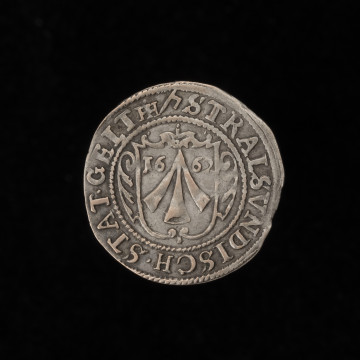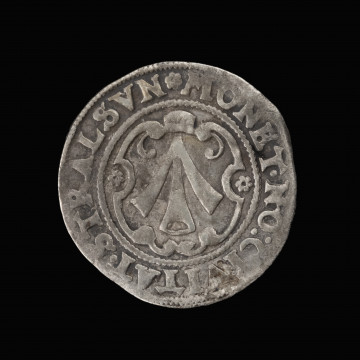
1/24 of a thaler (groschen)
1666
National Museum in Szczecin
Part of the collection: Scrip
Tin coins minted in Greifswald in 1631, along with the Strasund siege coppers from 1628, are among the oldest substitute money in Pomerania. In May of that year, during the occupation of the city by imperial troops, Colonel Francesco di Perusi (around 1590–1631) demanded money from the city council to pay the wages of his soldiers. There was no more silver in the city, and the planned confiscation of the townspeople's copper and tin was ineffective, so coins were only minted in tin. The coin was produced in the form of one-, two-, three- and four-ounce tin discs. At the price of 1 Stralsund schilling per ounce of tin, the coins had a value of 1, 2, 3 and 4 schillings. However, despite the threatened penalties, the merchants did not want to honour the siege money, and if they decided to do so, they charged aggio, i.e. compensation of up to 100% of the value of the goods. The replacement tin money was to be exchanged for silver, but the sources do not provide any information that after the city was shortly occupied by the Swedes on June 16, the newly appointed city authorities fulfilled this obligation. The design of siege issues was uniform regardless of the denomination – a double-headed imperial eagle under a crown and the title of the ruler placed on the obverse, and the coat of arms of Greifswald separating the date 1631 with the denomination designation and a phrase expressing the need for issue on the reverse. Only the 1-ounce coin is available in two versions, differing only in the diameter of the reverse stamp. The presented one-ounce coin, containing 83.12% tin, 10.77% lead, 5.58% iron and trace amounts of other elements, belongs to the variety with a smaller stamp. The collections of the Numismatics Department of the National Museum in Szczecin also include pieces weighing 4 ounces. Mieszko Pawłowski
Other names
Blei-Notmünze zu 1 Unze
Object type
token coin, siege money
Technique
bicie stemplem
Material
tin, lead, iron
Origin / acquisition method
acquisition
Creation time / dating
Creation / finding place
Owner
Muzeum Narodowe w Szczecinie
Identification number
Location / status

1666
National Museum in Szczecin

1647
National Museum in Szczecin

1930 — 1939
National Museum in Szczecin
DISCOVER this TOPIC
National Museum in Szczecin
DISCOVER this PATH
Educational path